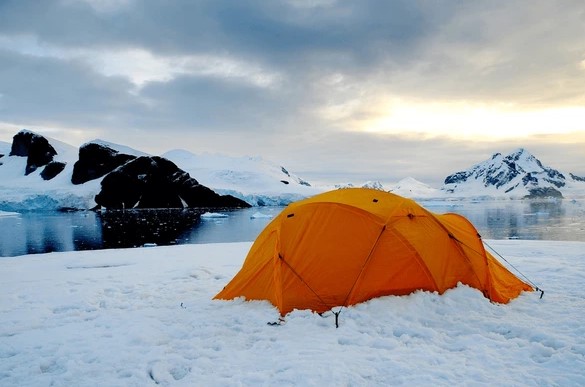
Camping is often associated with forests, mountains, or coastal beaches—but for the truly adventurous, the ultimate frontier lies at the bottom of the world. Antarctica camping is not your typical outdoor experience; it’s an extraordinary journey into one of the planet’s most extreme and untouched environments. Offering a rare opportunity to sleep beneath the Southern Hemisphere’s star-filled skies amid glaciers and icebergs, Antarctica camping attracts explorers seeking a deeper connection with nature and a firsthand encounter with one of Earth’s last wilderness frontiers.
1. What Makes Camping in Antarctica Unique
Camping in Antarctica is unlike any other outdoor activity on Earth. There are no trees, no permanent campsites, and no easy routes to convenience. What you do find is a pristine and raw environment dominated by vast ice fields, surreal silence, and stunning natural light displays like the aurora australis.
Unlike most camping experiences where you bring your own gear or set up a tent near a trailhead, Antarctica camping is conducted through guided expeditions due to the region’s remote and hostile nature. These excursions are typically offered as part of multi-day voyages from Ushuaia, Argentina—the southernmost city in the world—and often include landings by zodiac boats and overnight stays on the ice.
Sleeping under the open polar sky might sound dangerous, but commercial operators have developed safe and environmentally responsible ways to let travelers experience this bucket-list adventure. Most camps involve digging out snow pits or building wind shelters with gear specially designed for sub-zero conditions. There are no tents with heaters, no fire pits, and no artificial lights—just insulated sleeping bags, bivouac sacks, and thermal layers.
2. Safety, Regulations, and Environmental Responsibility
Camping in Antarctica is not without its challenges—and rightly so. The continent’s extreme climate, delicate ecosystems, and strict international regulations make planning and execution crucial. Visitors are subject to the rules outlined in the Antarctic Treaty System, a set of international agreements that governs human activity on the continent to ensure environmental protection.
The International Association of Antarctica Tour Operators (IAATO) plays a key role in ensuring that camping and other activities are carried out responsibly. IAATO-certified operators follow rigorous guidelines, including restrictions on the number of visitors per site, designated camping zones, and strict leave-no-trace principles.
Campers are not allowed to bring food ashore, to minimize the risk of contaminating local environments. Human waste must be collected and removed, and nothing—not even rocks or feathers—is to be taken as a souvenir. This emphasis on minimal impact reflects the continent’s vulnerability and the global importance of preserving its ecosystems.
Subheading: Preparing for the Extreme
Anyone considering Antarctica camping must be prepared both mentally and physically. Although you don’t need to be an elite athlete, a reasonable level of fitness and the ability to handle extreme cold are essential. Campers typically undergo a pre-landing briefing, where they’re introduced to safety protocols, gear usage, and emergency procedures.
Clothing is critical—layers are the key to surviving the sub-zero temperatures. Campers are usually advised to wear a moisture-wicking base layer, an insulating mid-layer, and a waterproof, windproof outer layer. Special insulated boots, gloves, face masks, and headgear are also required.
But preparation isn’t just physical. Mentally, the isolation and silence of Antarctica can be overwhelming. There’s no Wi-Fi, no distractions, and minimal contact with the outside world. For many, however, this unplugged, immersive experience is exactly what makes the adventure so profound.
3. Wildlife Encounters and Natural Wonders
Despite the harsh environment, Antarctica teems with wildlife. From your snow-covered campsite, you may witness penguin colonies, hear the calls of Weddell seals, or watch albatrosses soar overhead. While camping regulations ensure minimal disturbance to fauna, the opportunity to quietly observe these animals in their natural habitat is unforgettable.
At night, the Antarctic sky reveals another spectacle. With no light pollution, the Milky Way stretches across the sky in stunning clarity. During the right season, campers may even be lucky enough to catch a glimpse of the aurora australis, or southern lights—a shimmering curtain of green and purple lights dancing across the polar sky.
Beyond the wildlife and sky shows, the very act of being there is a wonder. The sheer isolation, the silence broken only by the cracking of glaciers, and the knowledge that you are one of the few humans to have ever spent a night on the continent give the experience a surreal, almost spiritual quality.
In conclusion, Antarctica camping is more than just a travel trend—it’s a profound journey into the heart of the Earth’s last great wilderness. Combining adventure, discipline, and awe-inspiring beauty, it challenges both body and mind while offering an unmatched connection to nature. For those willing to brave the cold and adhere to strict environmental ethics, camping in Antarctica offers a rare opportunity to sleep on the ice, under the stars, and among the wild. It’s an experience that leaves a lasting impression and a deeper appreciation for the fragile majesty of our planet’s southernmost continent.